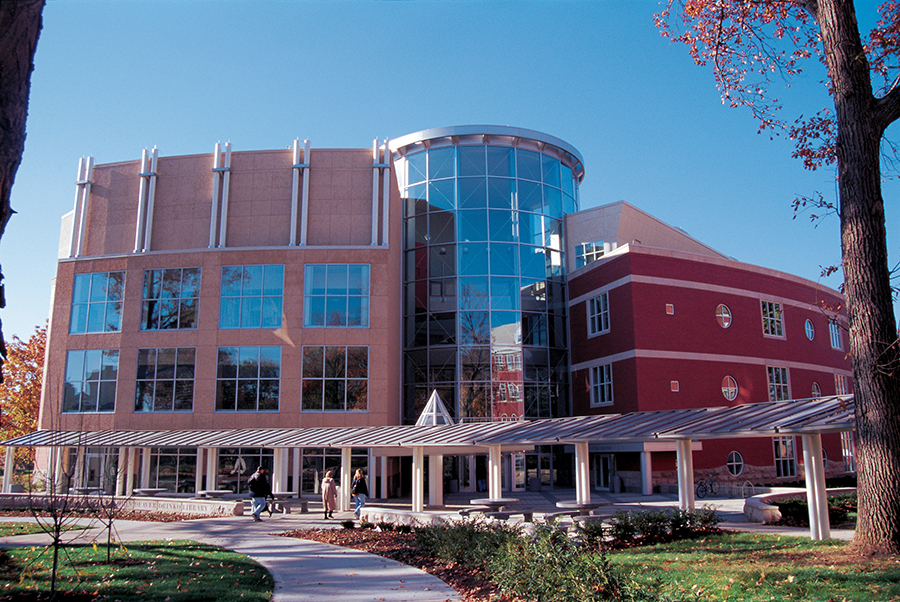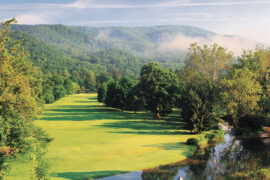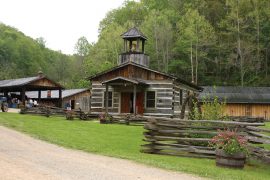A state of the art library puts technology to work
By Dave Wellman
HQ 33 | AUTUMN 1998
Marshall University President J. Wade Gilley calls the impressive new John Deaver Drinko Library “the heart of a campus committed to first-rate education for the 21st Century.” Until recently, though, seeing that library open for business on the Marshall University campus was only a dream. But this fall, that dream came true. One of the most ambitious goals of Gilley’s career was realized in a big way when the $31 million library opened to students on October 12, 1998.
Gilley proudly witnessed the official opening and dedication two weeks later, more than seven years after declaring the need for such a facility a top priority at MU. “I knew when I came in 1991 that it was on top of the list,” Gilley said. Today, the massive building is serving students, faculty and the general public on the land where Northcott Hall once stood. The library is a stunning combination of modern architecture inside, including a five-story atrium that sends light cascading through the building, and a more traditional, historic look outside.
Gilley, the faculty, students and community are all thrilled with every inch of the new library, which measures 118,000 square feet, and replaces the aging James E. Morrow Library which is located just a couple of hundred yards away. The Morrow library now is used mostly for research.
“It’s just first class all the way,” Gilley said of the new library. The library was named for John Drinko, a 1942 Marshall graduate who contributed more than $2.3 million to the construction project. Drinko, an internationally prominent attorney out of Cleveland, Ohio, used his donations as incentives for others to give as Marshall undertook an enormous fund raising campaign in 1995. The strategy worked as 2,300 people donated more than $10 million to the library. “The little ones were just as important as the big ones,” Drinko asserted.
Gilley praised those who gave. “It happened because our alumni giving doubled, students agreed to pay a library fee and Friends of the Library came through,” he said.

The other $21 million used to finance the library came from state bond money totaling $16 million and a $5 million federal grant.
The four stories of the facility house University Libraries, Computing Services, Telecommunications, Instructional Technology and Information Technology. The building has seating for nearly 600 people, 390 private study desks and computer carrels, 26 single and group study rooms with computers and computer hook-ups, three large collaboration rooms with teleconferencing capabilities and nearly 200,000 volumes of books.
Most impressive, many Marshall officials believe, are the high-speed Internet connections available to students, faculty and general public. The Virtual Library Information System is available via the Internet to serve the learning community 24 hours a day.
Dr. Ralph J. Turner, a longtime professor of journalism and mass communications at Marshall, is excited about the unlimited opportunities his co-workers and students now have.
“You’re going to see a lot of journalism majors over in that building all the time,” Turner said. “It’s a real plus for the School of Journalism. It’s a selling point to attract quality students, plus it does a better job of helping us in information-gathering in the School of Journalism.
“It’s going to be so much easier having top-notch equipment and extended hours.”
Drinko said the library is a “beacon light” for Marshall, the community and the area.
“If the Huntington and Charleston areas grow, Marshall will grow and vice versa,” he said.
A special area of the library has been designated for training faculty on how to use the technology, and on how to convert course materials into electronic form.
Other features of the library are color and poster-size copy machines, collaboration rooms and study rooms with computers for faculty and students.

The library also provides technology geared toward students with disabilities. It provides computers for hearing and visually impaired students, as well as computers set at certain heights for individuals with wheelchairs and computers with special keyboards for those who have trouble using their hands.
“It took a little longer than we thought,” Gilley said. “But it’s the best finished academic building that I have ever seen.”
The area outside the front entrance of the library, between Old Main and the Memorial Student Center, was the target of major landscaping most of the summer. New sidewalks, light poles and benches were added, and the outside of Old Main was cleaned and renovated, with nearly 600 new windows installed.
Trees, flowers and shrubs were planted as well in an effort to bring the area up to speed with the new library. An 8-foot statue of John Marshall, which cost $118,000, was erected on the plaza near the library and dedicated October 23.
“The statue portrays that Marshall was a man of vigor, with a lot of energy,” said Donald Van Horn, dean of the College of Fine Arts. “But at the same time, it gives the notion of him being a common man. Even though he was chief justice, he thought of himself as a common man and wanted to be close to the people.”
The furniture inside the library, Gilley determined, had to be top quality as well as comfortable and attractive. Gilley said the furnishings inside and landscaping outside, funded in part by the final $2 million in contributions, put “the finishing touches” on the project.
Drinko was emphatic that the library be built in its entirety now, rather than “halfway” as he says other Marshall buildings have been done in the past.
“All the other things Marshall has done, well, they were always running out of money and they didn’t build them right,” he said. “They started this when Wade came in and they said they were going to build the library halfway at first, then the other half later. I said, ‘Oh no. No more of that.’ So, we went out and gambled and didn’t hold back.”
While Drinko calls the library a beacon light for Marshall, and Gilley calls it the signature building on campus, Director of University Libraries Josephine Fidler says it’s “a real gathering place for the university.”
“It seems like more and more students like to work collaboratively,” she said. “They can do that in our study rooms, which accommodate as few as four and as many as 10.
“Our study center will have 55 computers available 24 hours a day. It’s an attractive place I know the students will enjoy.”

Monica Brooks, associate director of libraries for technology services, said “anyone can come in and use our facilities.” It is, however, necessary to purchase a library card for $25 a year to be able to check something out. Also, the 24-hour study period is off limits to the general public from 11 p.m. to 7:45 a.m.
Parking is available at all Marshall lots after 7 p.m. Monday through Thursday and after 4 p.m. Friday. During the day, there are 60 two-hour metered spaces across from the student center, and 30 10-hour metered spaces near the Joan C. Edwards Performing Arts Center that the public can use.
Jan Fox, vice president for information technology at Marshall, said the library has “information from around the world.”
“This is Internet accessible to other libraries and repositories from around the world,” Fox said. “They simply have to digitize books and make them available to us.”
Gilley, who said he watched “eyes pop out” as friends and others toured the facility before it opened, at times has trouble containing his own enthusiasm when walking through the facility, or glancing at it from his office in Old Main.
“I dreamed about a state-of-the-art library that would unite the university and the region,” Gilley said. “And that dream came true.”





